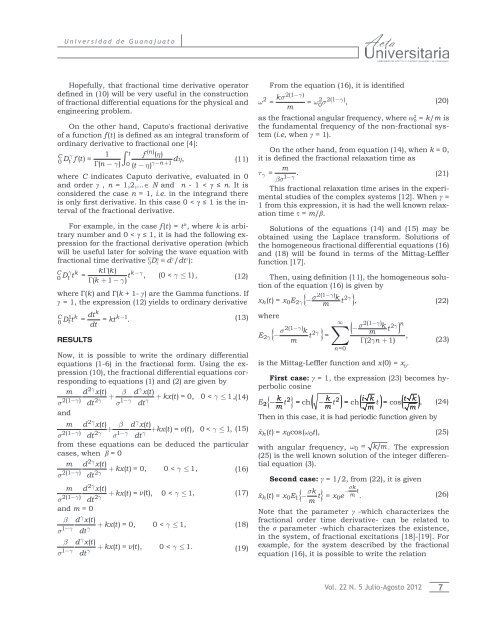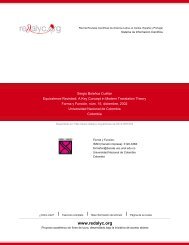A fractional calculus approach - Redalyc
A fractional calculus approach - Redalyc
A fractional calculus approach - Redalyc
You also want an ePaper? Increase the reach of your titles
YUMPU automatically turns print PDFs into web optimized ePapers that Google loves.
Universidad de Guanajuato<br />
Hopefully, that <strong>fractional</strong> time derivative operator<br />
defined in (10) will be very useful in the construction<br />
of <strong>fractional</strong> differential equations for the physical and<br />
engineering problem.<br />
On the other hand, Caputo's <strong>fractional</strong> derivative<br />
of a function f (t ) is defined as an integral transform of<br />
ordinary derivative to <strong>fractional</strong> one [4]:<br />
1 ( n )<br />
C γ<br />
t f ( η)<br />
0 Dtf()= t dη,<br />
(11)<br />
Γ( n −γ) 0 γ−<br />
n + 1<br />
( t − η) where C indicates Caputo derivative, evaluated in 0<br />
and order γ , n = 1,2,...∈ N and n - 1 < γ ≤ n. It is<br />
considered the case n = 1, i.e. in the integrand there<br />
is only first derivative. In this case 0 < γ ≤ 1 is the interval<br />
of the <strong>fractional</strong> derivative.<br />
For example, in the case f (t ) = t k , where k is arbitrary<br />
number and 0 < γ ≤ 1, it is had the following expression<br />
for the <strong>fractional</strong> derivative operation (which<br />
will be useful later for solving the wave equation with<br />
<strong>fractional</strong> time derivative C D γ ≡ d γ /dt γ<br />
0 t ):<br />
, (12)<br />
where Γ(k) and Γ(k + 1- γ) are the Gamma functions. If<br />
γ = 1, the expression (12) yields to ordinary derivative<br />
k<br />
C 1 k dt k − 1<br />
0 Dt t = = kt .<br />
(13)<br />
dt<br />
RESULTS<br />
Now, it is possible to write the ordinary differential<br />
equations (1-6) in the <strong>fractional</strong> form. Using the expression<br />
(10), the <strong>fractional</strong> differential equations corresponding<br />
to equations (1) and (2) are given by<br />
and<br />
,(14)<br />
, (15)<br />
from these equations can be deduced the particular<br />
cases, when β = 0<br />
2γ<br />
m d xt ()<br />
kx()=0, t 0 < γ 1<br />
2(1 γ) 2γ<br />
σ dt<br />
−<br />
+ ≤ , (16)<br />
, (17)<br />
and m = 0<br />
γ<br />
β d x() t<br />
kx()=0, t<br />
1 γ γ<br />
σ dt<br />
0 < γ 1<br />
−<br />
+ ≤ , (18)<br />
γ<br />
β d x() t<br />
kx()= t v( t),<br />
1 γ γ<br />
σ dt<br />
0< γ 1.<br />
−<br />
+ ≤ (19)<br />
From the equation (16), it is identified<br />
2(1 )<br />
2 kσ<br />
−γ<br />
2 2(1 − γ)<br />
ω = = ω0σ, (20)<br />
m<br />
as the <strong>fractional</strong> angular frequency, where ω2 0 = k/m is<br />
the fundamental frequency of the non-<strong>fractional</strong> system<br />
(i.e, when γ = 1).<br />
On the other hand, from equation (14), when k = 0,<br />
it is defined the <strong>fractional</strong> relaxation time as<br />
m<br />
τγ<br />
= .<br />
βσ1 γ −<br />
(21)<br />
This <strong>fractional</strong> relaxation time arises in the experimental<br />
studies of the complex systems [12]. When γ =<br />
1 from this expression, it is had the well known relaxation<br />
time = m/β.<br />
Solutions of the equations (14) and (15) may be<br />
obtained using the Laplace transform. Solutions of<br />
the homogeneous <strong>fractional</strong> differential equations (16)<br />
and (18) will be found in terms of the Mittag-Leffler<br />
function [17].<br />
Then, using definition (11), the homogeneous solution<br />
of the equation (16) is given by<br />
where<br />
is the Mittag-Leffler function and x(0) = x 0 .<br />
(22)<br />
(23)<br />
First case: γ = 1, the expression (23) becomes hyperbolic<br />
cosine<br />
Then in this case, it is had periodic function given by<br />
(24)<br />
( ) (25)<br />
with angular frequency, . The expression<br />
(25) is the well known solution of the integer differential<br />
equation (3).<br />
Second case: γ = 1/2, from (22), it is given<br />
(26)<br />
Note that the parameter γ -which characterizes the<br />
<strong>fractional</strong> order time derivative- can be related to<br />
the σ parameter -which characterizes the existence,<br />
in the system, of <strong>fractional</strong> excitations [18]-[19]. For<br />
example, for the system described by the <strong>fractional</strong><br />
equation (16), it is possible to write the relation<br />
Vol. 22 N. 5 Julio-Agosto 2012 7

















